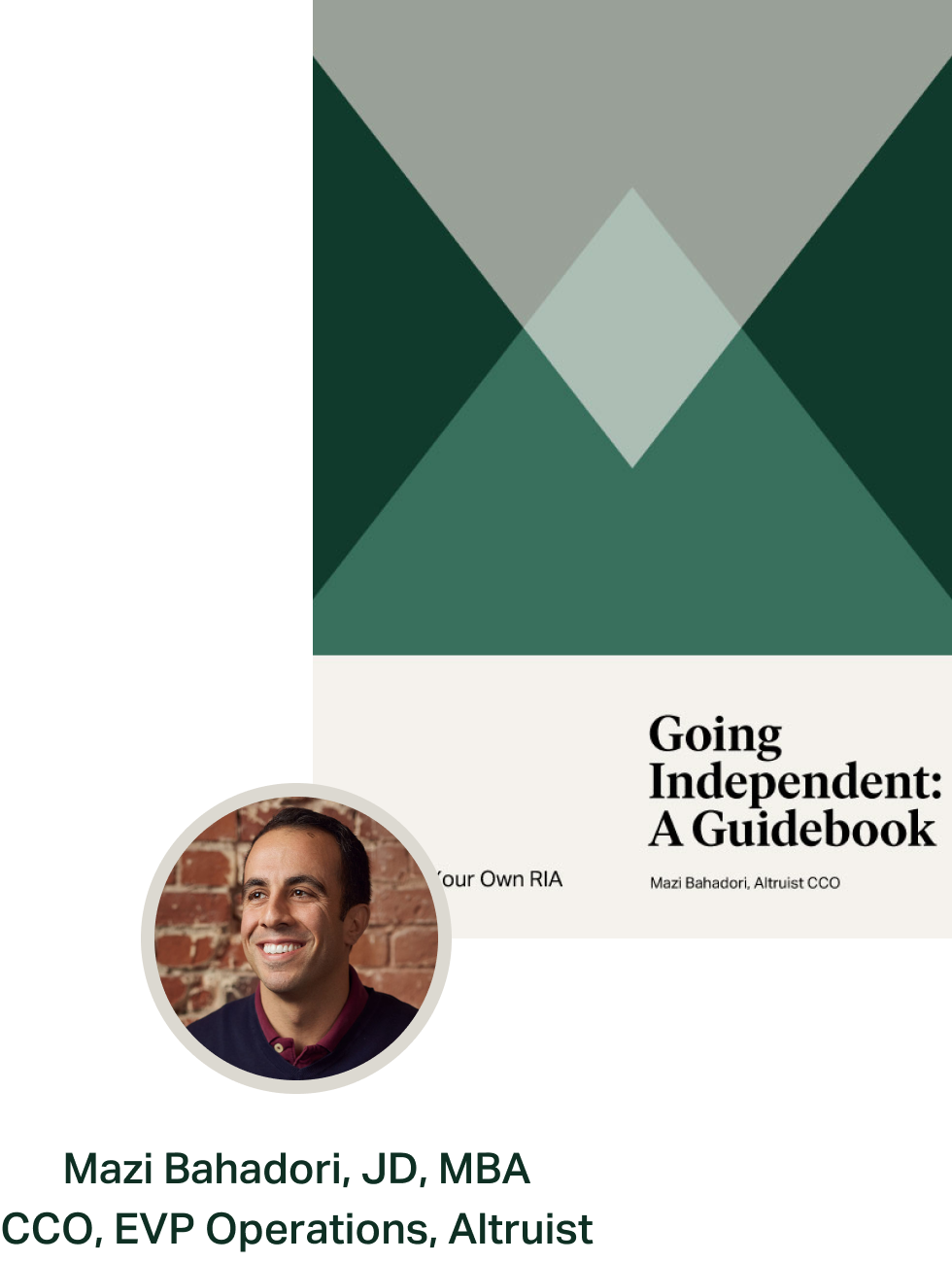Since we started this series, we’ve received several questions about the business basics for RIAs, such as getting an office space, purchasing adequate insurance coverage, hiring a team, finding the best accounting software, etc.
So far in our series, we've focused on the core components, so now let's look at the essential items you need to set up shop.
Key takeaways from this article:
- You'll learn exactly what you need from business administration to naming your RIA and setting up payroll.
- Take the time, in the beginning, to make intelligent business decisions and aim to automate your business. Doing so will save time and money for years to come.
- Spending time upfront to make intelligent decisions to help you automate your business will save you time and money for years to come.
- In case you missed it, we created a helpful launch kit to help you set up an RIA.
In this edition of Going Independent, we’re diving into the world of business administration while setting up your RIA. Basically, everything that helps you launch and run a business. It may not be exciting, but spending time up front to make intelligent decisions to help you automate as much of this as possible will save you time and money for years to come.
Naming your RIA
Many advisors often think of this when deciding to start their RIA. The four most commonly used words in any RIA company name tend to be: wealth, capital, advisors, and planning. And they tend to be used with the advisor’s last name.
A name can mean as much or as little as you want. Altruist, for example, was deliberately chosen because it reflects who we are, what we value, and what we want to accomplish. On the other hand, some of our customers opted for something as simple as Jane Doe Wealth Management because they feel they are the brand.
Consultants and marketing agencies can help you with this process but stick to your own devices in your early stages. Wait until you have a strong foundation and enough spare capital to carve out a good chunk for marketing. Hiring budget solutions in these areas never provides the ROI you need in the long run. To learn more about marketing your RIA, check out our additional resources.
 Website & Design for your RIA
Website & Design for your RIA
Depending on your budget, designing your website should be relatively easy with a service like Squarespace or similar. The goal of your website is to answer the following questions simply:
- What’s unique about my business?
- Why should anyone care about it?
- What’s my value proposition?
- How do I want to explain/present it?
- Who’s my ideal client?
- What motivates my ideal client to take action?
If you have room in your budget to hire a professional to build a website for your RIA, check out websites like Upwork or Working Not Working for experienced freelancers. You can also hire someone to design your logo, or write content for your website through both sites.
Whether you do it yourself or hire someone, remember to use those questions as your guide to ensure you share the right information with your prospective clients on your site.
Set up a corporate email
Establish a Gmail for Business account. It’s quick, easy to set up, and costs as little as $5 per month. If you have another preferred vendor, feel free to use them. But if email providers are a new thing to you, stick with Gmail.
You’ll want an email marketing service, too. Most new RIAs use Mailchimp, mainly because it’s free for up to 2,000 subscribers. You can look into Mailchimp’s standard and premier services if you have more email recipients or check out vendors like Intercom and Hubspot.
Setting up a business entity
If your budget permits, we recommend hiring an attorney. They will ensure all your i’s are dotted and t’s are crossed. However, if you can’t afford an attorney yet and you’re not bringing on a partner, a single-member LLC should be adequate for most advisors.
LegalZoom or RocketLawyer are cost-effective solutions if you choose to proceed on your own. We can’t give you legal advice and tell you how to structure an entity a certain way. But, we can tell you that most RIAs establish themselves as a Delaware LLC and give notice filings or registrations in the state(s) in which they operate. Using an online legal service is the least expensive way to establish your corporate entity and gives you basic liability protection.
Corporate Banking
First, go to the IRS website and get your EIN for your RIA. Once you’ve done that, go to whichever bank you already have a personal relationship with and establish a business banking account. Business banking products and offers change frequently, so it’s difficult to recommend the best business bank at any point–so go with what you prefer.
Websites like NerdWallet and PennyHoarder frequently publish surveys and reviews of banks and banking products. While they’re more focused on personal finance, they offer helpful insight into which banks run the best promotions in any given month.
The key factor to keep top of mind is to avoid fees. Unfortunately, most national banks are created equal, so there’s little differentiation between what you get at Wells Fargo versus Chase. Find a bank account that limits fees as much as possible.
Selecting Insurance for your RIA
There are six policies you’ll want to consider before you launch your RIA:
- Directors & Officers Liability
- Professional Indemnity
- Errors & Omissions Liability
- Fiduciary Liability
- Employment Practices Liability
- Health, Dental, and Vision
There’s no one size fits all approach to insurance coverage. Factors such as the size of your practice, number of accounts and clients, portfolio strategies and trading frequency, security types used, and number of employees you’ll hire all dictate the best coverage package. It could be that you only need basic E&O coverage for your first year. However, larger and more complex RIAs may need all six policies.
Finding an insurance broker you know and trust is critical for your long-term plans. In the short term, you can connect with firms like Napa or Chubb to find a policy that’ll provide adequate coverage at launch.
Office Space
Since COVID began, many companies have adopted a remote workforce or a hybrid approach to a few days in the office and a few days remote. Since remote work and meetings have become our new normal, it might make sense to skip a physical office.
However, it’s a personal decision between you and your clients. Think about your clients, their preferences, and your budget. If you’re serving clients near retirement, they may prefer to have in-person meetings. But if you’re serving millennials or younger, it’s more than likely, they’ll fully embrace virtual planning and check-in meetings.
If you want to adopt a hybrid between virtual and in-person, co-working spaces are a great choice and are much cheaper than renting a physical office space.
Hiring & Payroll
One of the easiest pieces of software to manage this process is Gusto. For $20 per month, you can rest assured that your hiring, onboarding, and payroll (and all associated taxes) are covered. However, there are plenty of options to explore, so choose the best fit for you.
Here’s why you should invest in automated payroll software. If you plan to grow a team, the fastest way to get into hot water with your state’s employment regulator is to make an error on some minor payroll withholding. And if you have an employee that files a complaint against you for any other reason, that minor error gives many state regulators grounds to challenge everything you’re doing. Using an automated payroll software will keep everything organized, and you won’t have to worry about these administrative issues.
Organizing financials for your RIA
This is an easy one: QuickBooks. It’s simple to set up, links with virtually every business bank account, integrate with most payroll providers, and is mainly hands-free. However, another option is to work with an accountant, which might be good if you plan to grow your firm and hire employees.
Next Steps
While there’s much more to setting up your RIA, these are often the areas that either get overlooked or lead you down rabbit holes. Keep the decision-making simple and set yourself up so you can spend time doing what matters most.
In case you missed it, be sure to catch up on the previous articles in the series:
- Going Independent: A series dedicated to starting your own RIA
- Going Independent: A guided checklist to forming your own RIA
- Going Independent: Choosing the best custodian for your RIA
- Going Independent: Let's get back to the (business) basics
- Going Independent: 6 mistakes advisors make on their Form ADV
- Going Independent: Registering your RIA with your state (or SEC)
- Going Independent: What does it cost to start your own RIA?
- Going Independent: How to transition clients to your new firm
About Altruist
At Altruist, we strive to make independent financial advice better, more accessible, and more affordable. Our custody solution gives back precious time and capital to RIAs, so you can focus on what matters most: your clients and business.
On one intuitive, integrated platform, advisors can open and fund accounts, trade and rebalance, report, and bill, at a fraction of today’s edging-ever-higher technology costs.
For new firms, existing firms, and advisors planning to make the leap from their wirehouse —the grass really is greener— our dedicated customer support team ensures a smooth transition and exceptional ongoing service.
To see how we’re helping RIAs streamline operations, reduce overhead, and elevate the client experience, talk with one of our advisor advocates today.















